Eglise Notre Dame des Rosaire de Tunis
- Post By: Dismalden
- Date:
- Category: abandoned, architecture, Holy places, medina, ruins, special places, urbex

Located in “Rue de l’Ecole”, in the southern entrance of the Medina near Bab el Jazira / Bab Jdid, and not far from Rue Tourbet el Bey. Legend says that this building was originally the home of a Turkish […]
Read MoreRomdhane Bey Palace / Dar Jouini
- Post By: Dismalden
- Date:
- Category: abandoned, architecture, medina, special places, urbex

Built in 1696 by Romdhane Bey, who spent less than 2 years in it before being beheaded. legend says that the head of Romdhane Bey rolled in this very house court. Then the palace passes through several owners, the […]
Read MoreEglise Sainte Croix in the Medina of Tunis.
- Post By: Dismalden
- Date:
- Category: abandoned, architecture, Holy places, medina, Rooftops, urbex

Built in 1662 by foreign Christians in the “europeans” part of the Medina of Tunis, This church is one of the oldest inside the medina, it even gave it’s name for a while to one of the most emblematic streets […]
Read MoreThe Palace where Giuseppe Garibaldi hid in Tunis

The Gnecco Palazzo is located in Rue de la Commission at the ending of the old Medina of Tunis in the part of town where the europeans used to reside. The Palazzo belonged to Paulo Antonio Gnecco a rich Italian […]
Read MoreThe pigeons of Zaytouna Mosque
- Post By: Dismalden
- Date:
- Category: Holy places, medina, streetphotography, urban wildlife

the title is self explanatory Share This:
Read MoreThe hidden Sea Level Markers all around the Medina.
- Post By: Dismalden
- Date:
- Category: abandoned, architecture, Curiosities, medina, streetphotography, urbex

While roaming around the old Medina of Tunis, you may look around and above you to admire the medieval islamic architecture but you rarely think of looking down, to your ankle level. All around the medina’s streets there is some […]
Read MoreThe Kitchy Art Deco buildings of Hafsiya
- Post By: Dismalden
- Date:
- Category: architecture, medina, special places, streetphotography, StreetswithPersonality, urbex

El Hafsiya used to be the jewish hood part of the old medina of Tunis. in the 1930ies , during the french colonial era, the hood was completely razed and re-built with some typical french colonial art deco style. Nowadays, […]
Read MoreThe luxurious kitsch and overladen decorated “Ksar Ezzahraa” Palace in the Medina.
- Post By: Dismalden
- Date:
- Category: architecture, medina, special places, urbex

This strange palace is located in the depth of the Medina of Tunis, in one of those small streets that you rarely passby by accident. It was closed and unknown for a long period then started with it’s new life […]
Read MoreInside the Abandoned Royal Mausoleum of Tourbet El Bey
- Post By: Dismalden
- Date:
- Category: abandoned, architecture, medina, ruins, special places, urbex

Tourbet El Bey is a Royal Mausoleum in the old Medina of Tunis, build to be the last resting place the Husainid dynasty the Ottoman rulers of Tunisia at that time. (more on the wikipedia page). As it’s name says, almost all […]
Read MoreInside the Abandoned Or Thora Synagogue of Hafsia
- Post By: Dismalden
- Date:
- Category: abandoned, architecture, medina, ruins, special places, urbex

The Or Thora Synagogue used to be a small synagogue in the Hafsia hood, the part of the old medina of Tunis where a community of Tunisian jew used to live, the hood was called the “Hara” at that time. […]
Read More